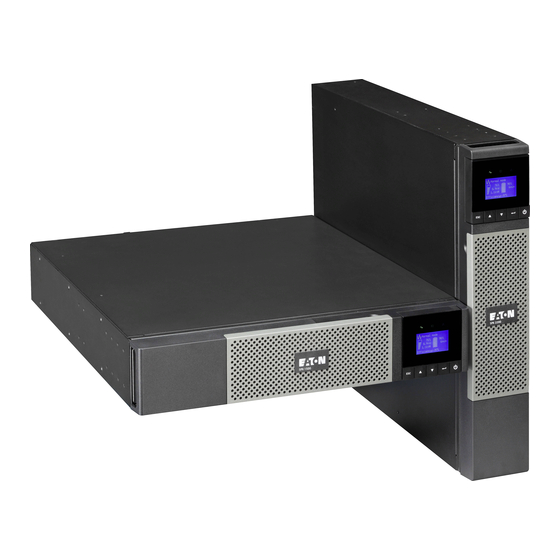
Table of Contents
Advertisement
Advertisement
Table of Contents

Summarization of Contents
1. Introduction
1.1 Environmental protection
Eaton's environmental protection policy and eco-design approach for products.
2. Presentation
2.1 Standard installations
Describes tower and rack installation configurations for UPS units and includes a weight and dimension table.
2.2 Rear panels
Details the rear panel connections and ports for different UPS models.
2.3 Control panel
Overview of the UPS front panel, its graphical LCD, buttons, and indicators.
2.4 LCD description
Explanation of the UPS LCD screen saver, backlight behavior, and status information.
2.5 Display functions
Information on navigating UPS menus and understanding display functions.
2.6 User settings
Configuration options for language, local settings, and input/output parameters.
ON/OFF settings
Settings related to UPS startup, shutdown, energy saving, and remote commands.
Battery settings
Configuration options for battery tests, warnings, charge modes, and deep discharge protection.
3. Installation
3.1 Unpacking and contents check
Details the components included with the UPS and provides a list of items.
3.2 Battery module connection
Instructions for connecting the internal battery module to the UPS unit.
3.3 Tower installation
Guide for installing the UPS unit in a vertical tower configuration.
3.4 Rack installation
Instructions for mounting the UPS unit into a standard 19-inch rack.
3.5 Communication ports
Information on connecting RS232, USB, or communication cards for UPS management.
3.6 Connection with a FlexPDU (Power Distribution Unit) module (optional)
Guide for connecting the UPS to an optional FlexPDU module.
3.7 Connection with a HotSwap MBP module (optional)
Instructions for connecting the UPS to an optional HotSwap MBP module.
HotSwap MBP module operation
Details on operating the HotSwap MBP module, including switch positions and LEDs.
3.8 UPS connection without a FlexPDU or HotSwap MBP module
Procedure for connecting the UPS directly to the AC power source and loads.
4. Operation
4.1 Start-up and Normal operation
Step-by-step guide for starting the UPS and verifying normal operation status.
4.2 Starting the UPS on Battery
Instructions for initiating UPS operation using battery power, with prerequisites noted.
4.3 UPS Shutdown
Procedure for safely shutting down the UPS unit through the front panel.
4.4 Operation on Battery Power
Details how the UPS operates when AC input power is unavailable, using battery energy.
Low-battery warning
Information on low battery status indicators and actions to take.
End of battery backup time
Description of indicators and events when the UPS battery backup time ends.
4.5 Return of AC Input Power
Procedure for UPS restart and load restoration upon AC power return.
4.6 UPS remote control functions
Details on using remote control functions like ROO and RPO.
5. Maintenance
5.1 Troubleshooting
Identifies common UPS operational issues and provides corrective actions.
Troubleshooting a UPS equipped with the HotSwap MBP module
Specific troubleshooting steps for UPS units integrated with the HotSwap MBP module.
5.2 Battery-module replacement
Step-by-step guide for safely removing and replacing the UPS battery module.
5.3 Maintenance on a UPS equipped with the HotSwap MBP module
Procedures for maintaining a UPS that is equipped with the HotSwap MBP module.
6. Appendices
6.1 Technical specifications
Provides detailed technical data including output power, AC input, battery, and environmental specifications.
6.2 Glossary
Definitions of technical terms and acronyms used in the manual.













Need help?
Do you have a question about the 5PX 1500 RT2U and is the answer not in the manual?
Questions and answers